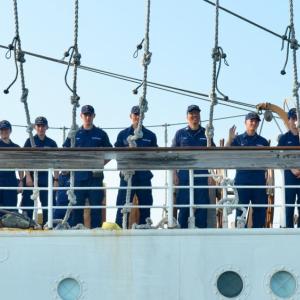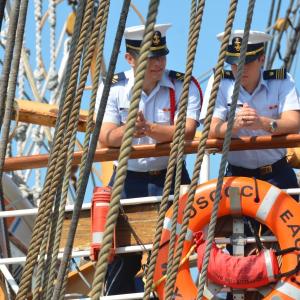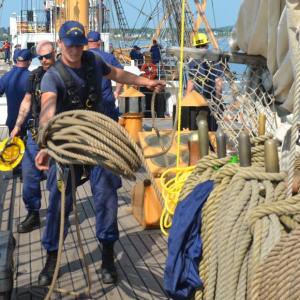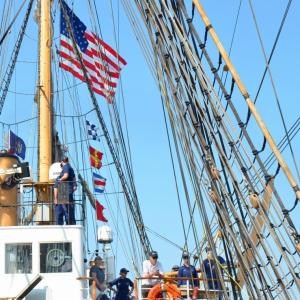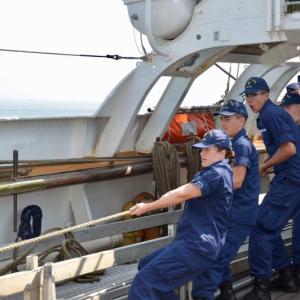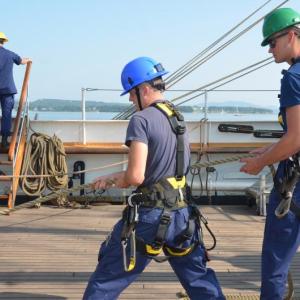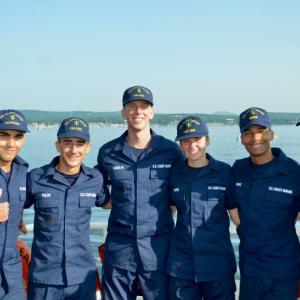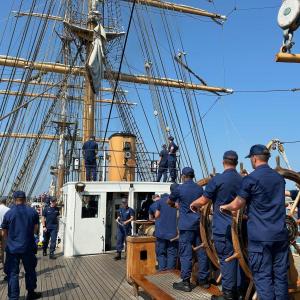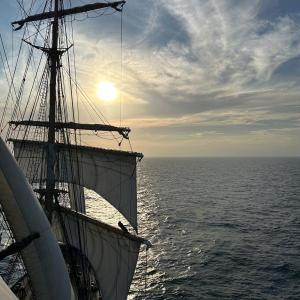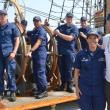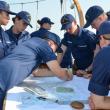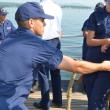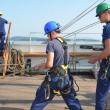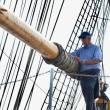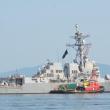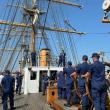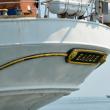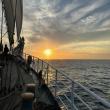Coast Guard families, dignitaries, friends mix with cadets and crew aboard treasured training ship Eagle
 U.S. Coast Guard Academy cadets and Eagle crew members help steer the Eagle into Rockland Harbor, Aug. 2. There are four Coast Guard Academy cadet fourth class selects, and two Eagle crew members behind Captain Jessica Rozzi-Ochs and Maine’s U.S. Senator Angus King. (Photo by Lynda Clancy)
U.S. Coast Guard Academy cadets and Eagle crew members help steer the Eagle into Rockland Harbor, Aug. 2. There are four Coast Guard Academy cadet fourth class selects, and two Eagle crew members behind Captain Jessica Rozzi-Ochs and Maine’s U.S. Senator Angus King. (Photo by Lynda Clancy)
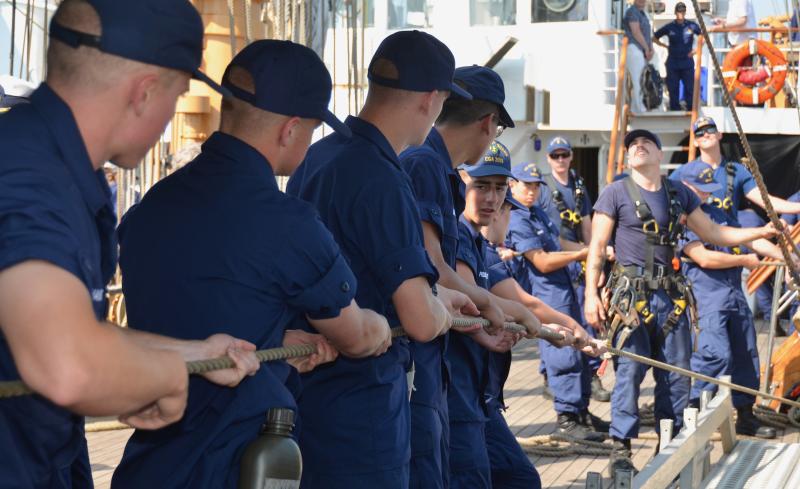 Pulling in the lines in tandem aboard the Eagle. (Photo by Lynda Clancy)
Pulling in the lines in tandem aboard the Eagle. (Photo by Lynda Clancy)
 U.S. Coast Guard Barque Eagle cadets line to decks Aug. 2 to welcome visitors aboard the ship. (Photo by Lynda Clancy)
U.S. Coast Guard Barque Eagle cadets line to decks Aug. 2 to welcome visitors aboard the ship. (Photo by Lynda Clancy)
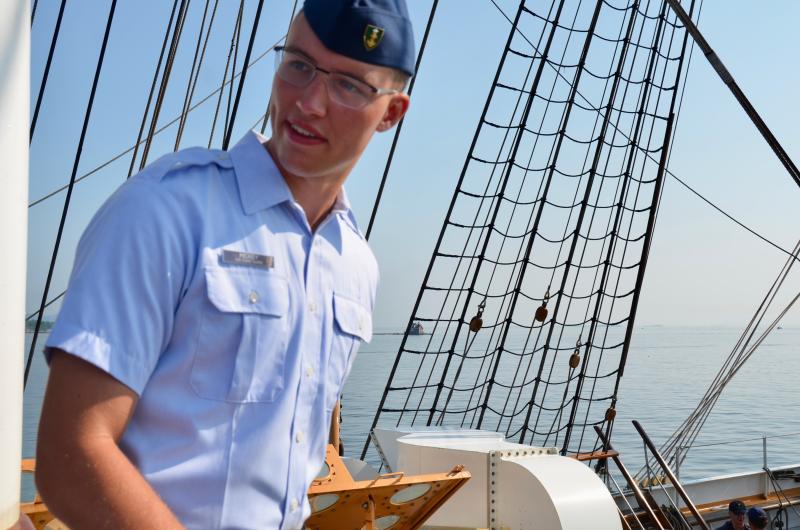 Lieutenant Junior Grade Zachary Beaudoin, of Scarborough, Maine, has been on the Eagle since 2022 as a deck watch officer. He and the several other watch officers are responsible for the safe operation of the ship, and a direct representative of Captain Jessica Rozzi-Ochs when she is not present. He came into the Coast Guard from officer candidate school, and prior to that, he was with the U.S. Marine Corps. “I really love the Coast Guard mission. You are saving lives and helping the homeland.” His wife is also from Scarborough, and in the Coast Guard herself, stationed at the Academy. They have two sons. “I am planning to make a career of this. I love the Coast Guard and looking forward to serving more.” Preferably in New England, and maybe Maine, they hope. (Photo by Lynda Clancy)
Lieutenant Junior Grade Zachary Beaudoin, of Scarborough, Maine, has been on the Eagle since 2022 as a deck watch officer. He and the several other watch officers are responsible for the safe operation of the ship, and a direct representative of Captain Jessica Rozzi-Ochs when she is not present. He came into the Coast Guard from officer candidate school, and prior to that, he was with the U.S. Marine Corps. “I really love the Coast Guard mission. You are saving lives and helping the homeland.” His wife is also from Scarborough, and in the Coast Guard herself, stationed at the Academy. They have two sons. “I am planning to make a career of this. I love the Coast Guard and looking forward to serving more.” Preferably in New England, and maybe Maine, they hope. (Photo by Lynda Clancy)
 Foundational training aboard the Eagle includes learning how to chart courses and understand, as well as employ, navigation skills. From left to right: U.S. Coast Guard Cutter Eagle (WIX 327) crewmember Ensign Michael Pagan-Selby, U.S. Coast Guard Academy Cadet 4th Class Select Delia Massell, U.S. Coast Guard Academy Cadet 4th Class Select Amelia Matson. (Photo by Lynda Clancy)
Foundational training aboard the Eagle includes learning how to chart courses and understand, as well as employ, navigation skills. From left to right: U.S. Coast Guard Cutter Eagle (WIX 327) crewmember Ensign Michael Pagan-Selby, U.S. Coast Guard Academy Cadet 4th Class Select Delia Massell, U.S. Coast Guard Academy Cadet 4th Class Select Amelia Matson. (Photo by Lynda Clancy)
 Logan Schwartz, of Cape Elizabeth, graduated from Cape Elizabeth High School last June, the Class of 2024. He was ready to step into his future and, “decided the military would be a great way to go about that.” The CG, he felt, was the right fit for himself. Schwartz is in basic training, and will be back at the Academy for several more weeks of basic training and then will begin classes in the fall. He has 39 classmates in his division, Bravo, and the total class size is approximately 300 now going through basic training. (Photo by Lynda Clancy)
Logan Schwartz, of Cape Elizabeth, graduated from Cape Elizabeth High School last June, the Class of 2024. He was ready to step into his future and, “decided the military would be a great way to go about that.” The CG, he felt, was the right fit for himself. Schwartz is in basic training, and will be back at the Academy for several more weeks of basic training and then will begin classes in the fall. He has 39 classmates in his division, Bravo, and the total class size is approximately 300 now going through basic training. (Photo by Lynda Clancy)
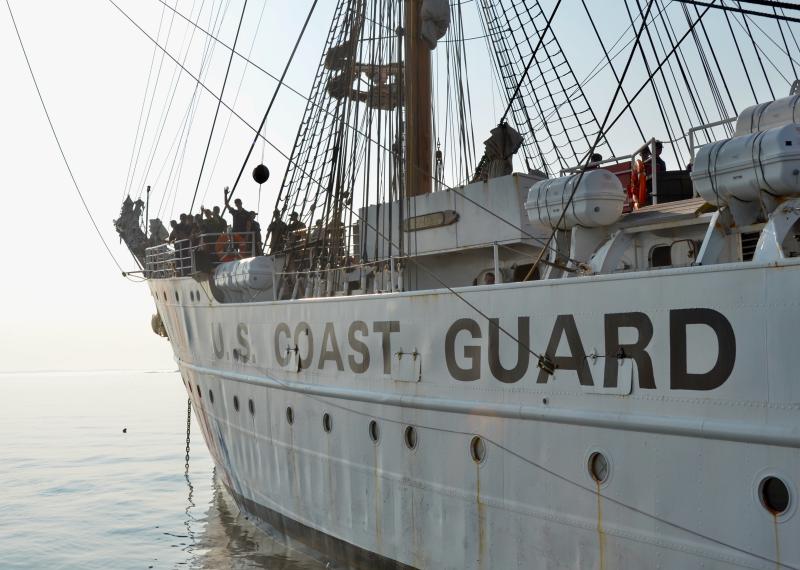 The Eagle at anchor near Owls Head in Penobscot Bay, Aug. 2, 2024. (Photo by Lynda Clancy)
The Eagle at anchor near Owls Head in Penobscot Bay, Aug. 2, 2024. (Photo by Lynda Clancy)
 In the Eagle’s pilot house:
In the Eagle’s pilot house:
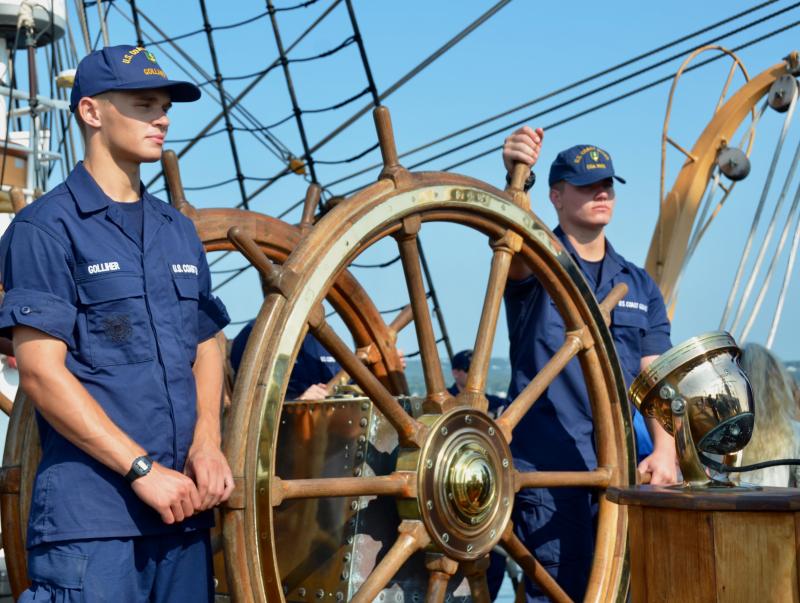 At the wheel on the Eagle,U.S. Coast Guard Academy Cadet 4th Class Select Stuart Golliher, And unknown 4th Class Select
(Photo by Lynda Clancy)
At the wheel on the Eagle,U.S. Coast Guard Academy Cadet 4th Class Select Stuart Golliher, And unknown 4th Class Select
(Photo by Lynda Clancy)
 Officers aboard the Eagle. (Photo by Lynda Clancy)
Officers aboard the Eagle. (Photo by Lynda Clancy)

 From left to right, U.S. Coast Guard Cutter Eagle (WIX 327) Culinary Specialists 2nd Class Fallon Ferguson and Kenlee Mars. (Photo by Lynda Clancy)
From left to right, U.S. Coast Guard Cutter Eagle (WIX 327) Culinary Specialists 2nd Class Fallon Ferguson and Kenlee Mars. (Photo by Lynda Clancy)

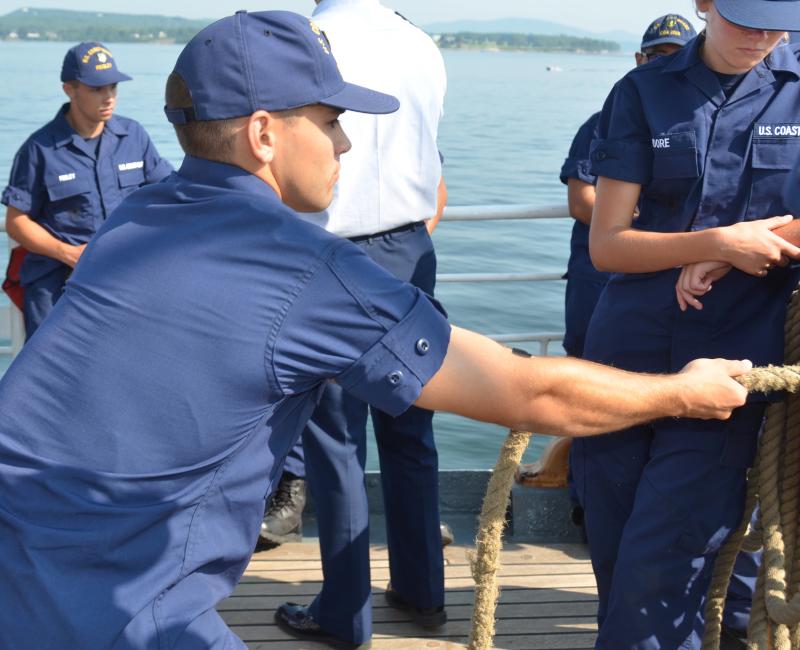
 U.S. Coast Guard Cutter Eagle (WIX 327) Petty Officer 3rd Class William Friesenhahn. (Photo by Lynda Clancy)
U.S. Coast Guard Cutter Eagle (WIX 327) Petty Officer 3rd Class William Friesenhahn. (Photo by Lynda Clancy)
 Chief Bosun Lee Currier, at the right, is in charge of the Eagle. He is the sail master and is in charge of everything to do with sailing, and sailing is one of the primary objectives of the Eagle. (Photo by Lynda Clancy)
Chief Bosun Lee Currier, at the right, is in charge of the Eagle. He is the sail master and is in charge of everything to do with sailing, and sailing is one of the primary objectives of the Eagle. (Photo by Lynda Clancy)
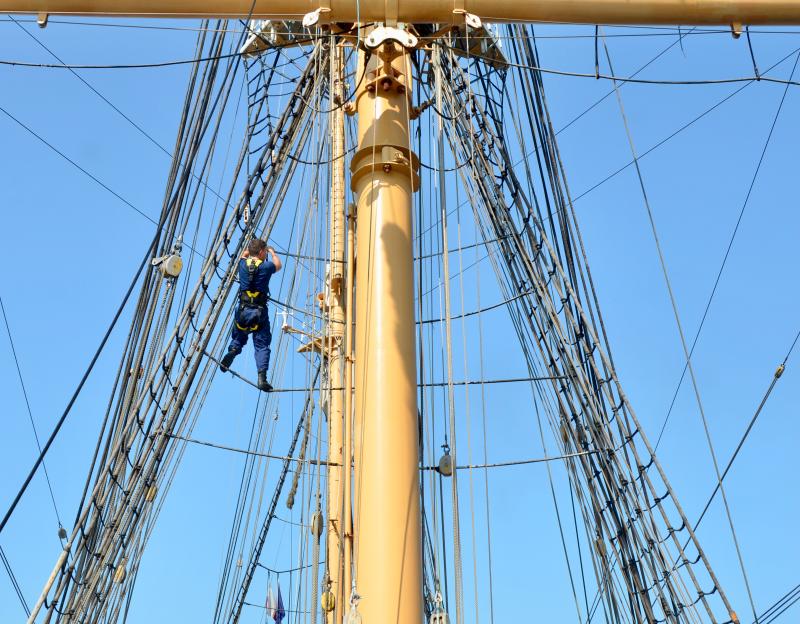 Up in the rigging, an important part of training aboard the Eagle. (Photo by Lynda Clancy)
Up in the rigging, an important part of training aboard the Eagle. (Photo by Lynda Clancy)
 Chief Bosun Lee Currier (Photo by Lynda Clancy)
Chief Bosun Lee Currier (Photo by Lynda Clancy)
 (Photo by Lynda Clancy)
(Photo by Lynda Clancy)
 U.S. Coast Guard Academy Cadet 4th Class Select Alyssa Cook. (Photo by Lynda Clancy)
U.S. Coast Guard Academy Cadet 4th Class Select Alyssa Cook. (Photo by Lynda Clancy)

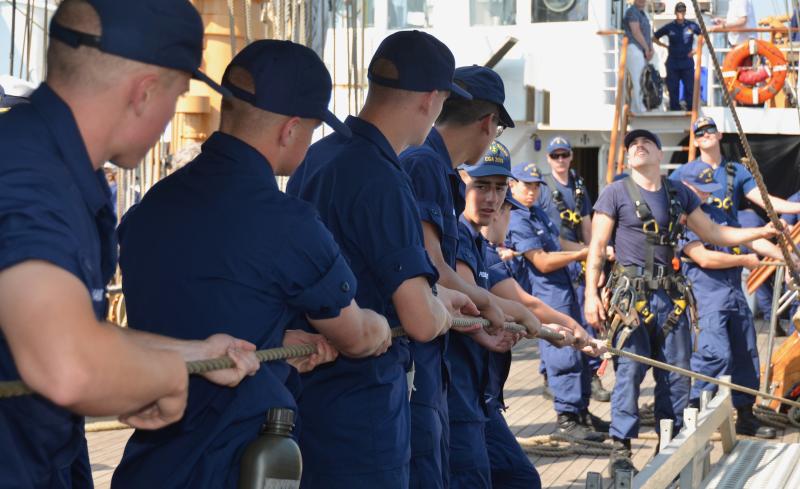





 Rockland Police Officer Troy Peasley. (Photo by Lynda Clancy)
Rockland Police Officer Troy Peasley. (Photo by Lynda Clancy)
 Owls Head lighthouse
Owls Head lighthouse



 Cadets Hashem Alhadidi, of Jordan; Sam Puleio, of Tinton Falls, N.J.; Parker Anselm, Puyallup, Washington; Morgan Moore, of Stafford, Virginia; Christos Burns, of Trinity, Florida; and Dylan Eirerdink, of Hernando Beach, Florida. (Photo by Lynda Clancy)
Cadets Hashem Alhadidi, of Jordan; Sam Puleio, of Tinton Falls, N.J.; Parker Anselm, Puyallup, Washington; Morgan Moore, of Stafford, Virginia; Christos Burns, of Trinity, Florida; and Dylan Eirerdink, of Hernando Beach, Florida. (Photo by Lynda Clancy)
 The U.S. Navy guided missile destroyer USS Delbert D. Black was also on the outskirts of Rockland Harbor Aug. 2.
The U.S. Navy guided missile destroyer USS Delbert D. Black was also on the outskirts of Rockland Harbor Aug. 2.
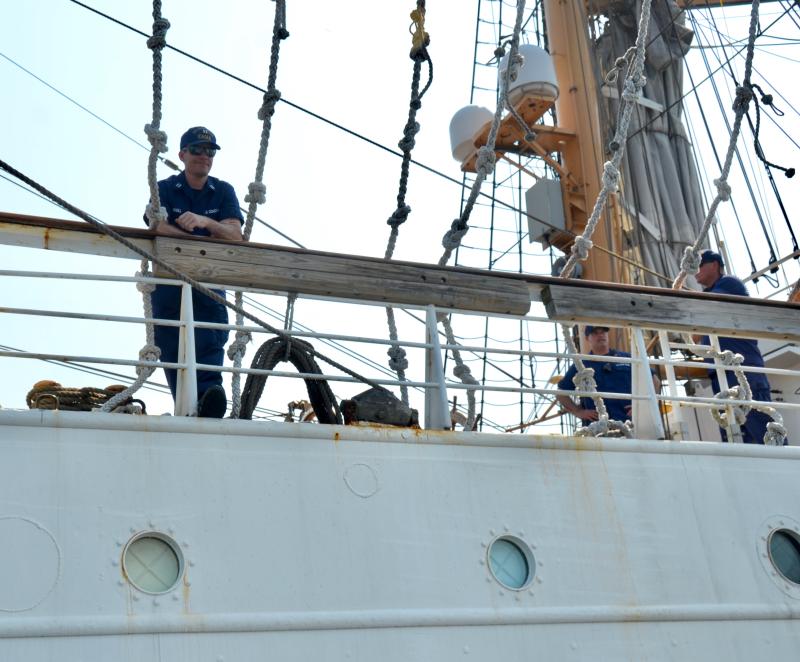
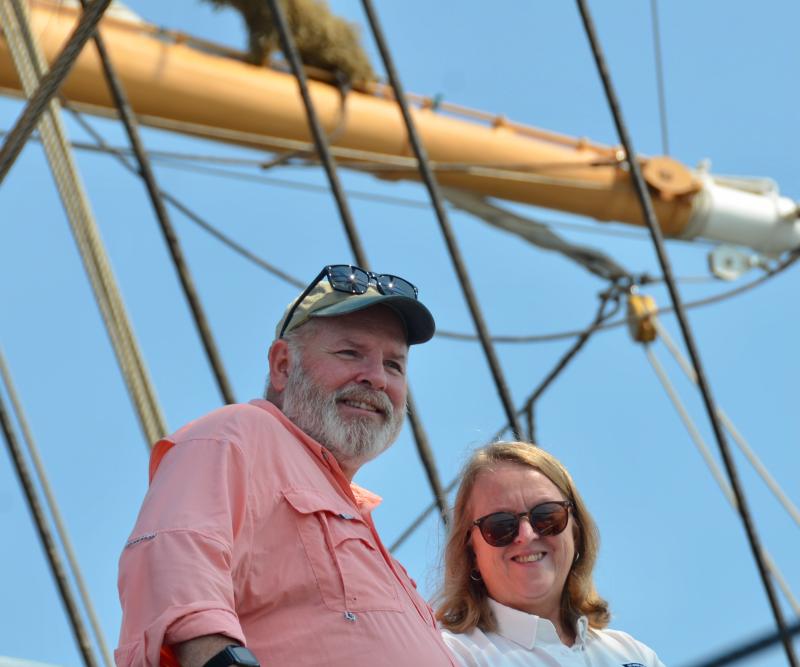 Hope resident and former sail master aboard the Eagle Ray Sisk and his wife, Lela. (Photo by Lynda Clancy)
Hope resident and former sail master aboard the Eagle Ray Sisk and his wife, Lela. (Photo by Lynda Clancy)
 U.S. Coast Guard Cutter Eagle (WIX 327) Commander Justin Feller, executive officer of Eagle, and Lieutenant Junior Grade Adalea Severs, cadet training officer and supply officer. (Photo by Lynda Clancy)
U.S. Coast Guard Cutter Eagle (WIX 327) Commander Justin Feller, executive officer of Eagle, and Lieutenant Junior Grade Adalea Severs, cadet training officer and supply officer. (Photo by Lynda Clancy)

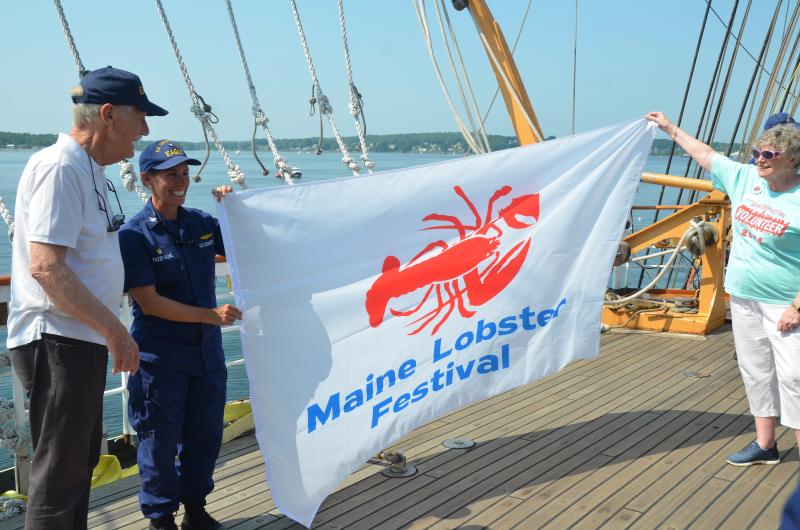 Senator Angus King, Capt. Jessica Rozzi-Ochs and a member of the Lobster Festival Committee unfurl a banner to help celebrate the annual Lobster Festival in Rockland.
Senator Angus King, Capt. Jessica Rozzi-Ochs and a member of the Lobster Festival Committee unfurl a banner to help celebrate the annual Lobster Festival in Rockland.
 Senator Angus King and Courier Gazette Reporter Stephen Betts. (Photo by Lynda Clancy)
Senator Angus King and Courier Gazette Reporter Stephen Betts. (Photo by Lynda Clancy)

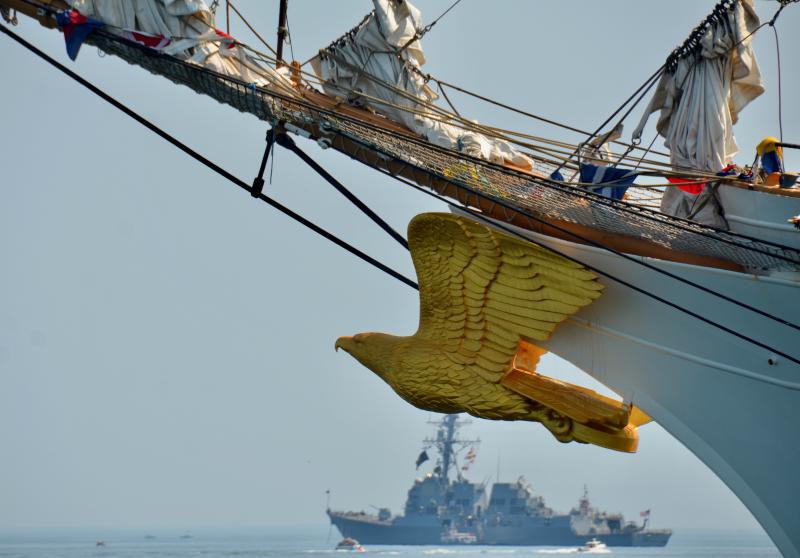

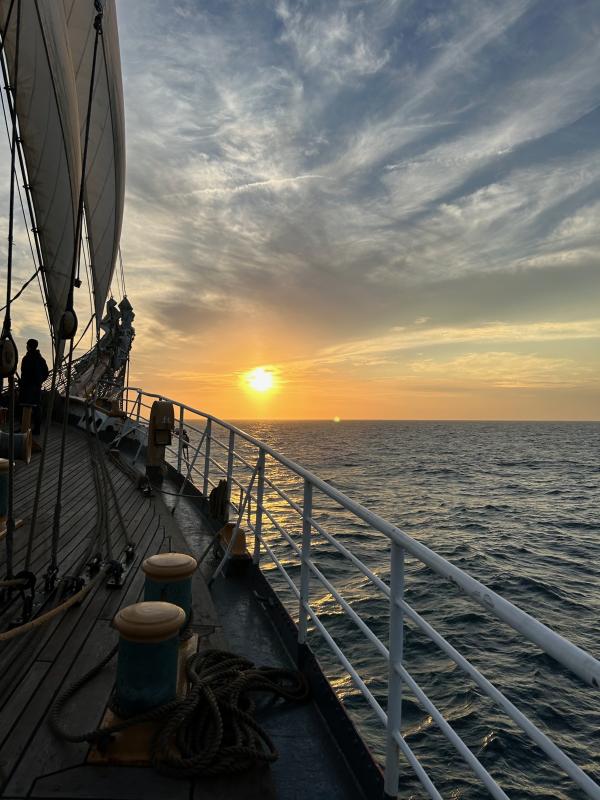 A view over the Atlantic, from a perch high in the rigging on the U.S. Coast Guard barque Eagle. (Photo courtesy Sam Puleio)
A view over the Atlantic, from a perch high in the rigging on the U.S. Coast Guard barque Eagle. (Photo courtesy Sam Puleio)
 A view over the Atlantic, from a perch high in the rigging on the U.S. Coast Guard barque Eagle. (Photo courtesy Sam Puleio)
A view over the Atlantic, from a perch high in the rigging on the U.S. Coast Guard barque Eagle. (Photo courtesy Sam Puleio)
 U.S. Coast Guard Academy cadets and Eagle crew members help steer the Eagle into Rockland Harbor, Aug. 2. There are four Coast Guard Academy cadet fourth class selects, and two Eagle crew members behind Captain Jessica Rozzi-Ochs and Maine’s U.S. Senator Angus King. (Photo by Lynda Clancy)
U.S. Coast Guard Academy cadets and Eagle crew members help steer the Eagle into Rockland Harbor, Aug. 2. There are four Coast Guard Academy cadet fourth class selects, and two Eagle crew members behind Captain Jessica Rozzi-Ochs and Maine’s U.S. Senator Angus King. (Photo by Lynda Clancy)
 Pulling in the lines in tandem aboard the Eagle. (Photo by Lynda Clancy)
Pulling in the lines in tandem aboard the Eagle. (Photo by Lynda Clancy)
 U.S. Coast Guard Barque Eagle cadets line to decks Aug. 2 to welcome visitors aboard the ship. (Photo by Lynda Clancy)
U.S. Coast Guard Barque Eagle cadets line to decks Aug. 2 to welcome visitors aboard the ship. (Photo by Lynda Clancy)
 Lieutenant Junior Grade Zachary Beaudoin, of Scarborough, Maine, has been on the Eagle since 2022 as a deck watch officer. He and the several other watch officers are responsible for the safe operation of the ship, and a direct representative of Captain Jessica Rozzi-Ochs when she is not present. He came into the Coast Guard from officer candidate school, and prior to that, he was with the U.S. Marine Corps. “I really love the Coast Guard mission. You are saving lives and helping the homeland.” His wife is also from Scarborough, and in the Coast Guard herself, stationed at the Academy. They have two sons. “I am planning to make a career of this. I love the Coast Guard and looking forward to serving more.” Preferably in New England, and maybe Maine, they hope. (Photo by Lynda Clancy)
Lieutenant Junior Grade Zachary Beaudoin, of Scarborough, Maine, has been on the Eagle since 2022 as a deck watch officer. He and the several other watch officers are responsible for the safe operation of the ship, and a direct representative of Captain Jessica Rozzi-Ochs when she is not present. He came into the Coast Guard from officer candidate school, and prior to that, he was with the U.S. Marine Corps. “I really love the Coast Guard mission. You are saving lives and helping the homeland.” His wife is also from Scarborough, and in the Coast Guard herself, stationed at the Academy. They have two sons. “I am planning to make a career of this. I love the Coast Guard and looking forward to serving more.” Preferably in New England, and maybe Maine, they hope. (Photo by Lynda Clancy)
 Foundational training aboard the Eagle includes learning how to chart courses and understand, as well as employ, navigation skills. From left to right: U.S. Coast Guard Cutter Eagle (WIX 327) crewmember Ensign Michael Pagan-Selby, U.S. Coast Guard Academy Cadet 4th Class Select Delia Massell, U.S. Coast Guard Academy Cadet 4th Class Select Amelia Matson. (Photo by Lynda Clancy)
Foundational training aboard the Eagle includes learning how to chart courses and understand, as well as employ, navigation skills. From left to right: U.S. Coast Guard Cutter Eagle (WIX 327) crewmember Ensign Michael Pagan-Selby, U.S. Coast Guard Academy Cadet 4th Class Select Delia Massell, U.S. Coast Guard Academy Cadet 4th Class Select Amelia Matson. (Photo by Lynda Clancy)
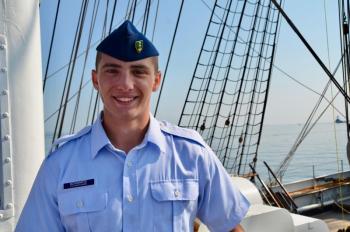 Logan Schwartz, of Cape Elizabeth, graduated from Cape Elizabeth High School last June, the Class of 2024. He was ready to step into his future and, “decided the military would be a great way to go about that.” The CG, he felt, was the right fit for himself. Schwartz is in basic training, and will be back at the Academy for several more weeks of basic training and then will begin classes in the fall. He has 39 classmates in his division, Bravo, and the total class size is approximately 300 now going through basic training. (Photo by Lynda Clancy)
Logan Schwartz, of Cape Elizabeth, graduated from Cape Elizabeth High School last June, the Class of 2024. He was ready to step into his future and, “decided the military would be a great way to go about that.” The CG, he felt, was the right fit for himself. Schwartz is in basic training, and will be back at the Academy for several more weeks of basic training and then will begin classes in the fall. He has 39 classmates in his division, Bravo, and the total class size is approximately 300 now going through basic training. (Photo by Lynda Clancy)
 The Eagle at anchor near Owls Head in Penobscot Bay, Aug. 2, 2024. (Photo by Lynda Clancy)
The Eagle at anchor near Owls Head in Penobscot Bay, Aug. 2, 2024. (Photo by Lynda Clancy)
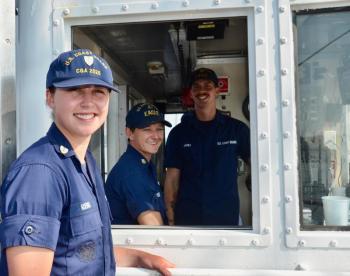 In the Eagle’s pilot house:
In the Eagle’s pilot house:
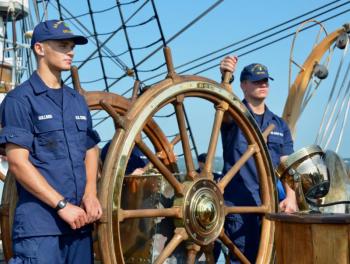 At the wheel on the Eagle,U.S. Coast Guard Academy Cadet 4th Class Select Stuart Golliher, And unknown 4th Class Select
(Photo by Lynda Clancy)
At the wheel on the Eagle,U.S. Coast Guard Academy Cadet 4th Class Select Stuart Golliher, And unknown 4th Class Select
(Photo by Lynda Clancy)
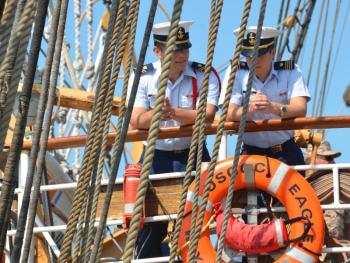 Officers aboard the Eagle. (Photo by Lynda Clancy)
Officers aboard the Eagle. (Photo by Lynda Clancy)

 From left to right, U.S. Coast Guard Cutter Eagle (WIX 327) Culinary Specialists 2nd Class Fallon Ferguson and Kenlee Mars. (Photo by Lynda Clancy)
From left to right, U.S. Coast Guard Cutter Eagle (WIX 327) Culinary Specialists 2nd Class Fallon Ferguson and Kenlee Mars. (Photo by Lynda Clancy)
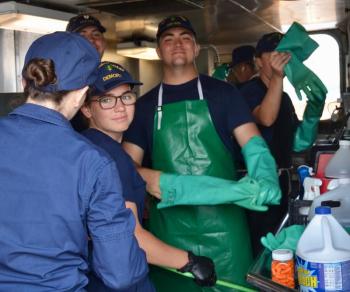

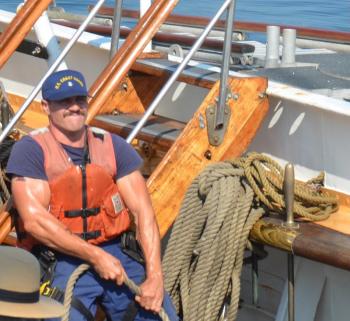 U.S. Coast Guard Cutter Eagle (WIX 327) Petty Officer 3rd Class William Friesenhahn. (Photo by Lynda Clancy)
U.S. Coast Guard Cutter Eagle (WIX 327) Petty Officer 3rd Class William Friesenhahn. (Photo by Lynda Clancy)
 Chief Bosun Lee Currier, at the right, is in charge of the Eagle. He is the sail master and is in charge of everything to do with sailing, and sailing is one of the primary objectives of the Eagle. (Photo by Lynda Clancy)
Chief Bosun Lee Currier, at the right, is in charge of the Eagle. He is the sail master and is in charge of everything to do with sailing, and sailing is one of the primary objectives of the Eagle. (Photo by Lynda Clancy)
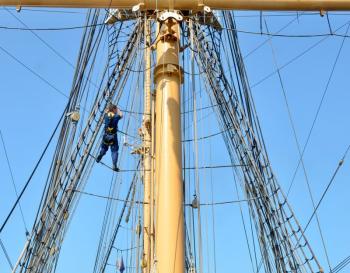 Up in the rigging, an important part of training aboard the Eagle. (Photo by Lynda Clancy)
Up in the rigging, an important part of training aboard the Eagle. (Photo by Lynda Clancy)
 Chief Bosun Lee Currier (Photo by Lynda Clancy)
Chief Bosun Lee Currier (Photo by Lynda Clancy)
 (Photo by Lynda Clancy)
(Photo by Lynda Clancy)
 U.S. Coast Guard Academy Cadet 4th Class Select Alyssa Cook. (Photo by Lynda Clancy)
U.S. Coast Guard Academy Cadet 4th Class Select Alyssa Cook. (Photo by Lynda Clancy)
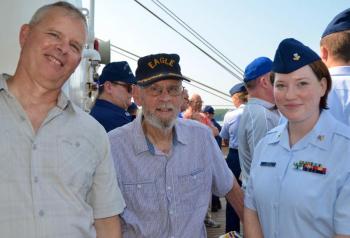
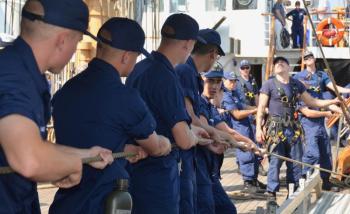




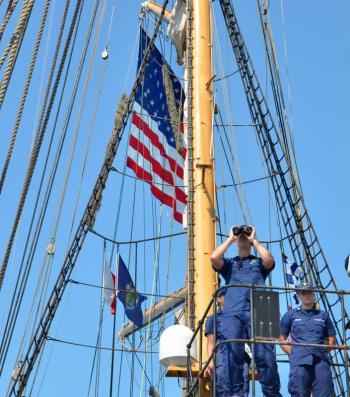
 Rockland Police Officer Troy Peasley. (Photo by Lynda Clancy)
Rockland Police Officer Troy Peasley. (Photo by Lynda Clancy)
 Owls Head lighthouse
Owls Head lighthouse



 Cadets Hashem Alhadidi, of Jordan; Sam Puleio, of Tinton Falls, N.J.; Parker Anselm, Puyallup, Washington; Morgan Moore, of Stafford, Virginia; Christos Burns, of Trinity, Florida; and Dylan Eirerdink, of Hernando Beach, Florida. (Photo by Lynda Clancy)
Cadets Hashem Alhadidi, of Jordan; Sam Puleio, of Tinton Falls, N.J.; Parker Anselm, Puyallup, Washington; Morgan Moore, of Stafford, Virginia; Christos Burns, of Trinity, Florida; and Dylan Eirerdink, of Hernando Beach, Florida. (Photo by Lynda Clancy)
 The U.S. Navy guided missile destroyer USS Delbert D. Black was also on the outskirts of Rockland Harbor Aug. 2.
The U.S. Navy guided missile destroyer USS Delbert D. Black was also on the outskirts of Rockland Harbor Aug. 2.

 Hope resident and former sail master aboard the Eagle Ray Sisk and his wife, Lela. (Photo by Lynda Clancy)
Hope resident and former sail master aboard the Eagle Ray Sisk and his wife, Lela. (Photo by Lynda Clancy)
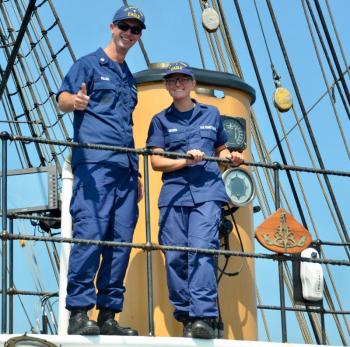 U.S. Coast Guard Cutter Eagle (WIX 327) Commander Justin Feller, executive officer of Eagle, and Lieutenant Junior Grade Adalea Severs, cadet training officer and supply officer. (Photo by Lynda Clancy)
U.S. Coast Guard Cutter Eagle (WIX 327) Commander Justin Feller, executive officer of Eagle, and Lieutenant Junior Grade Adalea Severs, cadet training officer and supply officer. (Photo by Lynda Clancy)

 Senator Angus King, Capt. Jessica Rozzi-Ochs and a member of the Lobster Festival Committee unfurl a banner to help celebrate the annual Lobster Festival in Rockland.
Senator Angus King, Capt. Jessica Rozzi-Ochs and a member of the Lobster Festival Committee unfurl a banner to help celebrate the annual Lobster Festival in Rockland.
 Senator Angus King and Courier Gazette Reporter Stephen Betts. (Photo by Lynda Clancy)
Senator Angus King and Courier Gazette Reporter Stephen Betts. (Photo by Lynda Clancy)
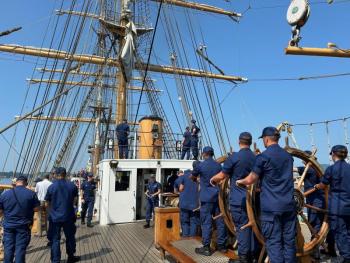


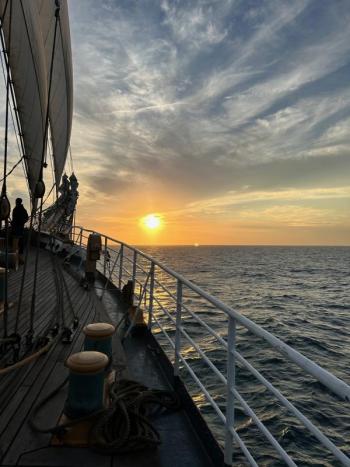 A view over the Atlantic, from a perch high in the rigging on the U.S. Coast Guard barque Eagle. (Photo courtesy Sam Puleio)
A view over the Atlantic, from a perch high in the rigging on the U.S. Coast Guard barque Eagle. (Photo courtesy Sam Puleio)
 A view over the Atlantic, from a perch high in the rigging on the U.S. Coast Guard barque Eagle. (Photo courtesy Sam Puleio)
A view over the Atlantic, from a perch high in the rigging on the U.S. Coast Guard barque Eagle. (Photo courtesy Sam Puleio)
PENOBSCOT BAY — Over the past weekend, the U.S. Coast Guard celebrated its 234th birthday, while Rockland was equally jubilant in becoming recertified as a Coast Guard City. But the highlight was a gathering aboard the U.S. Coast Guard barque Eagle, the pride and joy of the Coast Guard, with many of those who trained, or served as captain, officers and crew, aboard the distinctive vessel – the country’s largest tall ship flying the Stars and Stripes and the only active square-rigger in U.S. government service.
The Eagle had sailed into Penobscot Bay Aug. 1 and anchored beyond the Rockland Breakwater, the rugged yet graceful steel hull resting quietly in the calm summer sea.
Early in the morning, Aug. 2, a series of Coast Guard boat launches transported visitors — families, friends, dignitaries and former commanders and captains — to the Eagle to meet the ship, its crew and officers. It was a mini-reunion of sorts, for the Coast Guard family, built around their fondness for the barque Eagle.
Also on board was a representation of Coast Guard cadets, some fresh out of high school and in basic training, others already enrolled in the Coast Guard Academy in New London, Connecticut, and now on their seamanship details, sailing the New England coastline.
“The most important part of taking cadets out on the Eagle is training them to become the kind of future leaders the Coast Guard needs and should have,” said Lieutenant Junior Grade Zachary Beaudoin, of Scarborough, and a 2012 graduate of Scarborough High School.
He is a deck watch officer, and has been on the Eagle since 2022.
“We go through various types of training, including damage control, what it is like to be under way and navigation, because a lot of cadets are going to go on to other boats,” he said. “They are going to learn teamwork, overcoming fears, being comfortable with being uncomfortable. We represent the Coast Guard, and we represent America.”
At the helm was Captain Jessica Rozzi-Ochs, the first woman commanding officer of the Eagle, and the 31st commanding officer in a line of U.S. captains that dates back to 1946. And prior to that, there were 10 other captains when the ship was owned by Germany, and known then as the Horst Wessel under the Navy of Nazi Germany.
Rozzi-Ochs has been captain of the Coast Guard’s training ship since June 2022, and she is currently charged with guiding the ship, and the mission of teaching the next generation foundational knowledge about being at sea.
That incorporates climbing the rigging of the tallest masts, poring over compass roses to chart a course, gazing at the stars with a sextant to practice celestial navigation, peeling potatoes in the mess hall for meals that feed 150, standing watch at the bow with binoculars for hours at a stretch, and all the while, learning how to engage and support fellow crew, as well as take orders and ensure the vessel’s safe passage.
Rozzi-Ochs serves under Coast Guard Commandant Admiral Linda F. Fagan, who is likewise the first woman to occupy that highest position in the Coast Guard. With her officers and crew, Rozzi-Ochs had sailed the Eagle to Rockland to help commemorate the city’s recertification as a Coast Guard City.
The Eagle is the largest tall ship sailing under the U.S. flag, and the country’s only square-rigged vessel used in government service. At 295 feet in length, the Eagle is also the only active commissioned sailing vessel operating in the U.S. maritime services. The boat is collectively owned by taxpayers, and is a source of national pride. When her sails are full under a stiff breeze, she commands a presence on the water.
On Friday, Aug. 2, schooners, lobster boats and skiffs were circling around the Eagle in outer Rockland Harbor,. The ship’s anchoring was off of Owls Head, a strategic vantage point where the view stretched miles up Penobscot Bay toward Northport and across toward Vinalhaven, with Mt. Desert and Isle au Haut in the distance.
Nearby, the USS Delbert D. Black (DDG 119) was likewise anchored, and also in Rockland to help celebrate the 77th Maine Lobster Festival. The Navy vessel is guided-missile destroyer stationed in Mayport, Florida. She is the first ship to be named after the first-ever Master Chief Petty Officer of the Navy, Delbert D. Black.
Aboard the Eagle
The mood was light aboard the Eagle. Cadets were beaming and seasoned crew members were at work, hauling and resetting the Eagle’s anchor, while guiding the novice Coasties as they pulled lines and help set sails.
The Eagle was specifically built for seamanship training 77 years ago at the Blohm & Voss yard in Hamburg, Germany, commissioned by Hitler.
The U.S. Coast Guard acquired the Eagle from Germany in 1946, as a war reparation. A U.S. and German crew sailed the tall ship through a hurricane and into New York Harbor that year. Built for training military sailors, that remains its mission today and it is endowed with a maritime legacy that dates back centuries, even millennia. That heritage comes alive every time its square sails are hoisted proudly over the 147-foot-tall masts.
The Eagle has four sister ships, three of them apportioned to other countries following WWII. Mircea is owned by Romania; Sagres II, Portugal; Gorch Fock I, Germany (this ship returned to Germany after being owned by Russia, but then in need of repairs, was privately funded to go home).
In the interim, Germany had built another Gorch Fock II in 1958, based on the original Gorch Fock I design. The last time they all sailed together was in 1976 during the U.S. Bicentennial in New York Harbor.
But this summer, the Eagle is full of the future. Young cadets, who come from all over the U.S. and foreign countries, are full of dreams for careers in the Coast Guard.
To learn more about the Eagle’In addition to teaching seamanship, the Eagle is about leadership training, where everyone — crew, officers, admirals —learn from each other using a nautical language and precise set of commands as they “work the ship.” It is said that the best leaders learn how to follow.
In addition to cadets, there were longer-term Coast Guard crew members on board the Eagle, such as Trever Hammack, an electronic systems specialist, and photographer.
He is from Alaska, and eventually wants to return there, with its large Coast Guard presence and community involvement. That is what inspired him to join five years ago.
“I have family and friends who were saved by the Coast Guard,” he said.
Before his detail on the Eagle, he served on other vessels on the East Coast with counter-drug missions. Most recently, he was part of the Coast Guard team that rescued 394 Haitians in the Bahamas, who had been abandoned and without food and water for eight days aboard a small sailing vessel.
On his next assignment, he hopes to work on the aids to navigation teams, which includes maintaining lighthouses.
The Eagle, however, has been his number one choice, given the breadth of experience and seamanship training.
On Saturday’s visit, there was also nostalgia, as visitors walked the decks, reliving their personal past experiences.
There was the son of former Coast Guard Academy Superintendent Raymond J. Mauerman, who sat pensively on the foredeck as he took in all the activity. He had sailed aboard the Eagle for 11 weeks in 1955, to London, Scotland, France, Portugal and back to the East Coast.
He was not a cadet, but he was a paperboy and got to see and talk to cadets while his father ran the Academy. Later, he would join the Coast Guard.
With him was Rear Admiral John Mauger, now retired, but who was former First District Commander in charge of Coast Guard operations, and the 12,000 Coast Guard men and women, stationed from New Jersey to Canada.
“The mission of the Coast Guard Academy is to build a liking for the sea and its lure in the students and to come together as a team,” said Mauger. “They go through a rigorous training to get indoctrinated. But it really starts to come together once you get on board the ship.”
Which is distinctive from the U.S. Navy, both men agreed.
“The Navy does not have square rigs,” said Mauerman. “They don’t learn sailing under sail, which is a big difference.”
Down on the midship, finding shade in the “waist” of the boat, was former Eagle Captain David Wood, who took command of the ship from 1988 to 1992. That followed a prior decade of serving aboard five other Coast Guard cutters, and a Coastie career that started in 1962. Plus he taught English at the Coast Guard Academy and ship handling to naval officers, served as chairman and executive director of the American Sail Training Association (now Tall Ships America), and authored articles on sea education and sail training.
In 1989, he sailed the Eagle, with 250 cadets and 55 crew members, into Leningrad on a goodwill visit. They also visited France for the bicentennial of the French Revolution. In 1992, he took the Eagle to the Parade of Sail in Boston Harbor, an historic gathering.
These days, he lives in Topsham, and fishes for salmon Down East.
Looking around the Eagle on Aug. 2, Capt. Wood was pleased. In the background was the noise of the ship — orders delivered across the decks, the thrust of engines, and the ever- familiar “heave-ho,” as cadets pulled lines and secured them.
“Things are running well,” said Wood.
About the Eagle
The integrity of the boat lies in its superior design, craftsmanship, and durability.
Length: 295 feet
Beam: 39.1 feet
Draft: 17 feet
Ballast: 344 tons
Water: Holds 56,000 gallons
Height of the main and fore masts: 147.3 feet (above waterline)
Sail area: 21,350 square feet
Diesel engine: 1,000 horsepower, 16-cylinder Caterpillar (installed in 1980 and due for upgrade this coming year)
Speed under sail: up to 17.5 knots
Speed under power: 11 knots
Number of sails: 23
The boat is made from German steel, riveted together and welded together. The plating is half-inch thick.
The weather decks have three-inch teak laid atop the steel.
Nine watertight bulkheads run from the bilge to the main deck.
Learn more about the Eagle and the vessel’s schedule.



